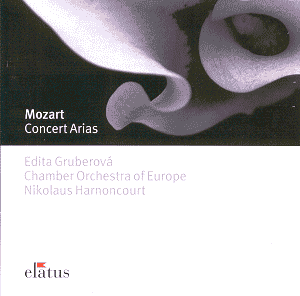Mozart
composed more than fifty arias in addition to those found within
his operas. He did so at every stage of his career, and always
for one of two reasons. The majority were conceived as 'insertion
arias' in an existing opera by himself or someone else, in order
to suit the needs of a particular singer. The other examples were
genuine 'concert arias', intended to display a singer's prowess
in the context of a concert performance, while still retaining
an operatic style. The great majority of these marvellous pieces
were composed for the soprano voice, but as this interesting compilation
shows, those for tenor are distinctive too. Together they form
a significant part of his creative work. Nor should their relative
neglect deflect from the excellence of the music, which is thoroughly
worthy of Mozart's genius.
This music
remains just as much a showpiece for singer today as it was in
Mozart’s own time. This fact is palpable when listening to Edita
Gruberová’s performances before a spellbound and well behaved
audience at two concerts in Vienna in the summer of 1791, which
no doubt formed part of the Mozart bicentenary tribute.
The sound
is full-bodied but details emerge well. If there is a criticism
to be made, it is the common one that the voice is too prominent
in the perspective of the recording. Perhaps this priority reflects
the concept of the ‘star singer’ giving a ‘star turn’.
Gruberová
has achieved a notable reputation for her vocal virtuosity, and
that reputation is justified here. Her security of tone is palpable,
and her ability to achieve chains of high notes is astonishing.
Evidently the audience at the Sofiensaal though so too, since
nearly half a minute of their applause is recorded to follow each
individual number. On CD this does become tiresome, so the listener
will need to have the remote control nearby.
Full texts
and translations are included in the nicely produced booklet,
albeit in extremely small print. There are some useful introductory
notes, which are written in chronological order of composition,
which is of course quite different the order of the performances
as recorded.
As for
the music, it is as glorious as we would expect of Mozart. In
his operas he preferred to collaborate as closely as possible
with his singers, to shape his music to their particular strengths
and characteristics. In concert arias this tended to be even more
strongly the case, of course.
The majority
of Gruberová’s programme dates from the early 1780s, just
before and just after Mozart’s move to Vienna. For example, ‘Ma
che vi fece’, K368, was written in Munich for Elisabeth Wendling,
the Elettra in his opera seria Idomeneo. It has all the characteristics
of that character’s music in the opera, and was intended in gratitude
as a showpiece for the singer, which in Gruberová’s sparkling
performance it certainly is.
However,
the most important historical link to emerge in this programme
is with Aloisia Lange (née Weber), for whom four of these
arias were composed. Mozart first encountered her, and fell in
love with her by all accounts, in Mannheim in 1777, while en route
for Paris. Four years later, he found that she and her family
had moved to Vienna. After his bold decision to leave the employ
of Archbishop Colloredo and to become a freelance musician, he
lodged with the Weber family, and in due course married Constanze,
Aloisia’s younger sister.
These arias
are magnificent examples of Mozart’s art. The first three of them
were intended as insertion arias in operas by Pasquale Anfossi.
In a letter to his father (dated 2nd July 1783), he
reports of K418 and K419: ‘Nothing except my arias was well received;
the second, which is a bravura piece, had to be repeated.’ From
this it is evident that Mozart valued these arias, and so should
we, since they entirely match the quality of those he composed
within his own operas.
Terry
Barfoot
